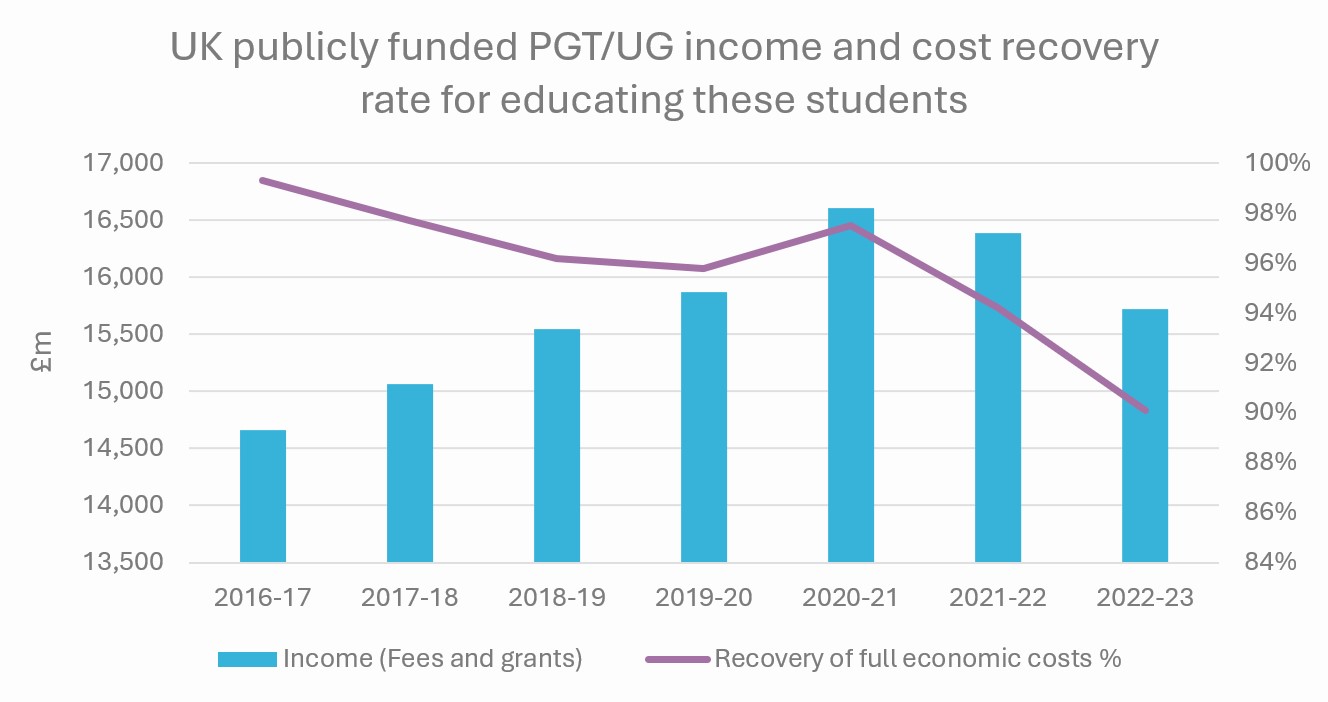As expected, putting the university sector on a firmer financial footing is high up on the priority list for the new Education Secretary.
Indeed, Bridget Phillipson announced that she is “working with officials to urgently understand what we need to do in order to shore up the sector.”
Increased attention from government on financial resilience is also likely to be matched by a renewed emphasis on university balance sheets from the Office for Students following the publication of the independent review of the regulator.
On TRAC?
New policy advisers across Treasury, DSIT and DfE will be considering the complex challenge of how to ease the increasing financial pressures on universities to avoid impacting key ambitions such as national and regional economic growth, filling skills gaps, improving public services, and driving a new industrial strategy. The recent release of the 2022-23 university sector finance data (TRAC) by the Office for Students (OfS) will be a useful guide as their work gets underway in earnest.
TRAC provides unique insight into the income and expenditure of all university activities, showing the extent to which the investment that universities received through government grants and student fees met the true cost of delivering those activities – called the full economic cost (FEC) recovery rate.
This release shows a continuation of a concerning trend. From 2016-17 to 2022-23, the total deficit on university activities in the UK increased by 155 per cent, from £1.2 billion to £3.1 billion.
This means that increasing costs and demands on delivery are outstripping levels of investment from external sources, despite universities successfully increasing this in recent years. The two main areas driving this trend are educating UK students, called “Teaching (publicly funded)” in the dataset and research.
Teaching (publicly funded)
The headline is that the FEC recovery rate for educating UK students has hit its lowest point since TRAC records began, with UK universities recovering only 90.1 per cent of the costs in 2022-23, representing a £1.7bn deficit that needs to be cross subsidised by surpluses found elsewhere. This is an aggregate across both undergraduate and postgraduate teaching – and as many universities make a slight surplus on postgraduate students the headline figure hides the scale of undergraduate underfunding.
When the fees were raised in England in 2012-13 and grant funding from government was subsequently decreased, the understood policy intent was for universities to make a slight surplus on educating undergraduate students and for this to be reinvested to improve quality and experience. Instead, due to frozen fees since 2017 in England, decreased real terms government investment and increasing costs, universities are now diverting their central funds which would previously have been spent on other activities such as R&D, to cover only the basic running costs of teaching.
This trend cannot continue indefinitely, and universities are already making choices about what they can and can’t continue to deliver. The risk is that this starts to impact quality and choice at the level of individual institutions, which will have knock on consequences nationally. For example, multiple universities stopping the same types of courses which leads to cold spots emerging across the UK.
Based on Bridget Phillipson’s recent comments it is unlikely that universities will see increased levels of investment. This means that the government will need to be clear about what they want universities to prioritise and then use the funding they do have to incentivise these priority activities. In the past this would have been a difficult task but with the newly announced coordinating body for skills provision – Skills England, it feels possible. However, the first step would be a difficult one – calculating the average cost of undergraduate education. Something the sector hasn’t submitted to the OfS through TRAC since before the pandemic. Bring back TRAC(T)? Surely not?

Research
The Research Council funding category in TRAC is one of the key drivers of R&D financial sustainability for universities, as it represents the largest proportion of UK research (22 per cent) and includes UKRI among other funders such as the Royal Society and the British Academy. As with educating domestic students, FEC recovery rates have continued to decrease over time hitting an all-time low this year of 69 per cent, down from 72 per cent in 2016-17. This trend of decreasing FEC recovery rates is true for all external research funders.
This could be seen as a positive story for government, as the sector appears to be delivering more for less. However, this has only been possible because universities have been using surpluses generated from educating international students, and also putting off capital expenditure. Continuing to delay capital spend and relying too heavily on international students to fund research deficits carries significant risks, especially given market volatility and uncertainty over student immigration policy.
Universities will increasingly need to prioritise which research they can afford to pursue, likely placing greater weight on achieving higher FEC recovery rates. Many may choose to reduce the amount of R&D they can perform overall, which may, for example, have consequences for overall research intensity in a region if other universities make similar choices. A focus on FEC recovery rate could also drive perverse incentives, with different grants or funders being chosen not because of their strategic vision but because they are investing at a financially sustainable rate.
To continue to drive the direction of university R&D, government will want to consider how it can improve financial sustainability with its own funding. It may also wish to influence other funding streams it wants to promote in the UK research funding landscape, such as medical research funding from the charity sector.
What to look out for in next year’s release
Although we can’t see this in the recent TRAC release, when the next data set comes out my eye will be on any changes to the own-funded research category – with any reduction in expenditure potentially representing the first sign of a shrinking sector.
This category represents R&D funded through universities’ central pot or directed philanthropy. It funds research that may be too novel or innovative to secure external funding but is critical to the UK’s research pipeline. It also supports those superstar early career researchers who the university sees great promise in but are not quite experienced enough to submit to UKRI and it helps to ensure top research talent stays in the UK.
I believe this expenditure, which is funded in part through Research England’s quality-related (QR) research funding (and its devolved equivalents) and in part from international student fees surpluses, is fundamental to the UK’s success in R&D. But if the trends we are seeing in the TRAC data continue, and universities are required to redirect these funds to cover the cost of externally funded research, activity at the start of the research pipeline is at risk.
We are therefore unlikely to see the impact of this on research council activity until a few years further down the line. But by then it will be too late, and we will have irreversibly lost talent and capacity in emerging areas of research. Government R&D strategy should consider and mitigate this risk.
Looking ahead
I am encouraged by Labour’s early recognition of the sector’s value and what we can bring as partners in their missions for the UK. However, given the continuation of trends seen in this TRAC release, the current fiscal environment and uncertainty in the international student market, it seems inevitable that universities will need to stop some activities at varying scales across the sector, which will impact students and R&D.
Although at the heart of university strategies is the ambition to do civic good, in a period of tight resources they will likely find themselves forced to make financially-led decisions they might otherwise prefer not to take. The risk for government is that multiple universities make the same decision, leading to regional cold spots in provision and irreversible loss in R&D capacity in areas the government is looking to encourage.
This is a complex problem to solve but with a new government comes the opportunity to evaluate and agree what role we want universities to play in filling high-level skills gaps, conducting R&D and supporting business and local communities. It will be important that this not only considers economic benefit but also the role universities play in culture and society more widely which often don’t fit neatly into standard profit and loss accounts – as we set out in our recent Places and People report.
From there we can agree on the most efficient use of public funding so universities can help to deliver on some of the government’s ambitions to drive change and growth in the UK.













An excellent article with great recommendations about bringing back TRAC (T) and thinking about research priorities. Two issues that flow from this are which areas should be the focus of any increase in the proportion of subjects being taught and researched if overall volumes are held constant, or reduced due to falling demand or constrained funding. Here there is scope for connection with the work of the Future Skills Unit within the DfE and the regional mayoral combined authorities. This will probably mean increases in health and medical sciences among other band A and B subject areas in the OfS… Read more »
It is time for the HE sector to drastically reduce expenditure across the board by cutting student numbers and research.
Only in this way will we ever get a sustainable sector. Courses need to be cut and institutions need to focus on the areas of activity they do best. Student choice must be reduced.
All expenditure on research should be match funded by investment from the private sector. There is too cosy a relationship between Governments and Academia and more and better evaluation of activity and outcomes is needed.
The issue with this – speaking as an academic who gets asked however many times a year it is to fill in a form for the time allocation survey that feeds into this dataset – is that the conclusions are drawn from what is just junk data. Firstly, in my institution, I am not aware of anyone who is tracking their time, and how it’s divided between different tasks, this is not and is never measured (hence the junk data claim). Secondly, I don’t know a single colleague who is certain about the narrow differences between the different categories. Thirdly,… Read more »
This is a well-written article… But then I read about a Russell Group university opening a campus in India, and can only conclude that the sector (or at least that particular university) has the wrong priorities, failing to focus on its core mission and wasting a lot of time and resources on a vanity project.